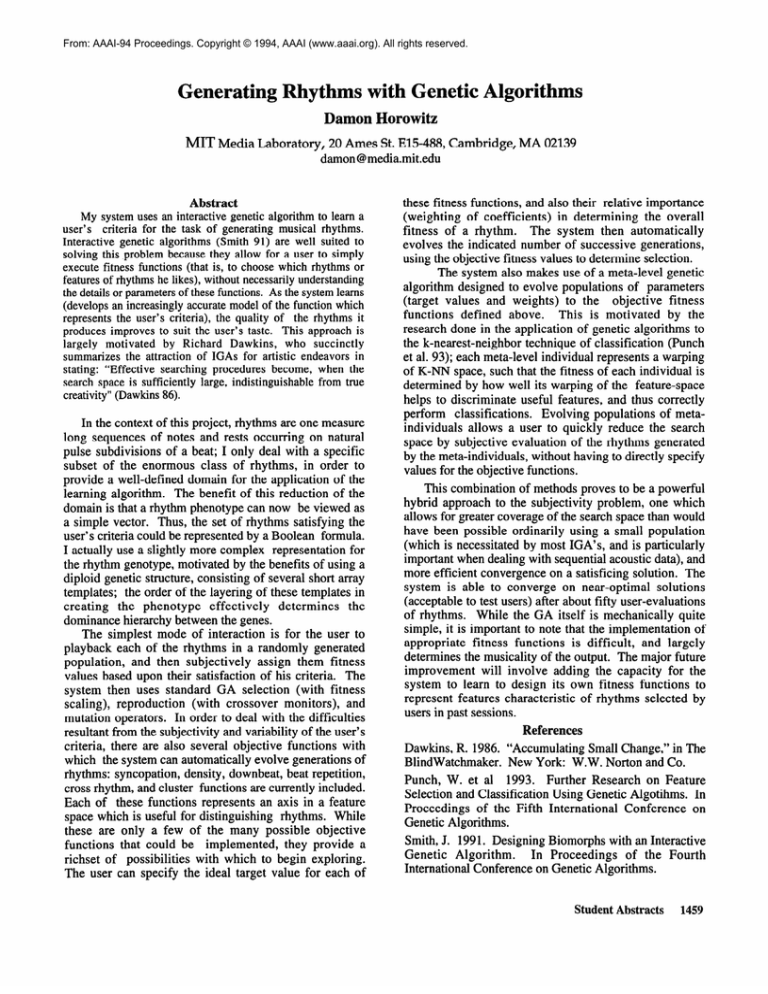
From: AAAI-94 Proceedings. Copyright © 1994, AAAI (www.aaai.org). All rights reserved.
Generating Rhythms with Genetic Algorithms
Damon Horowitz
MIT Media Laboratory,
20 Ames St. E15-488, Cambridge,
damon@media.mit.edu
Abstract
My system uses an interactive genetic algorithm to learn a
user’s criteria for the task of generating musical rhythms.
Interactive genetic algorithms (Smith 91) are well suited to
solving this problem because they allow for a user to simply
execute fitness functions (that is, to choose which rhythms or
features of rhythms he likes), without necessarily understanding
the details or parameters of these functions. As the system learns
(develops an increasingly accurate model of the function which
represents the user’s criteria), the quality of the rhythms it
produces improves to suit the user’s taste. This approach is
largely motivated by Richard Dawkins, who succinctly
summarizes the attraction of IGAs for artistic endeavors in
stating: “Effective searching procedures become, when the
search space is sufficiently large, indistinguishable from true
creativity” (Dawkins 86).
In the context of this project, rhythms are one measure
long sequences of notes and rests occurring on natural
pulse subdivisions
of a beat; I only deal with a specific
subset of the enormous class of rhythms, in order to
provide a well-defined domain for the application of the
learning algorithm.
The benefit of this reduction of the
domain is that a rhythm phenotype can now be viewed as
a simple vector. Thus, the set of rhythms satisfying the
user’s criteria could be represented by a Boolean formula.
I actually use a slightly more complex representation for
the rhythm genotype, motivated by the benefits of using a
diploid genetic structure, consisting of several short array
templates; the order of the layering of these templates in
creating
the phenotype
effectively
determines
the
dominance hierarchy between the genes.
The simplest mode of interaction
is for the user to
playback each of the rhythms in a randomly generated
population,
and then subjectively
assign them fitness
values based upon their satisfaction of his criteria. The
system then uses standard GA selection (with fitness
scaling), reproduction
(with crossover monitors),
and
mutation operators. In order to deal with the difficulties
resultant from the subjectivity and variability of the user’s
criteria, there are also several objective functions with
which the system can automatically evolve generations of
rhythms: syncopation, density, downbeat, beat repetition,
cross rhythm, and cluster functions are currently included.
Each of these functions represents an axis in a feature
space which is useful for distinguishing
rhythms. While
these are only a few of the many possible objective
functions that could be implemented,
they provide a
richset of possibilities
with which to begin exploring.
The user can specify the ideal target value for each of
MA 02139
these fitness functions, and also their relative importance
(weighting
of coefficients)
in determining
the overall
fitness of a rhythm.
The system then automatically
evolves the indicated number of successive generations,
using the objective fitness values to determine selection.
The system also makes use of a meta-level genetic
algorithm designed to evolve populations of parameters
(target values and weights) to the objective
fitness
functions
defined above.
This is motivated
by the
research done in the application of genetic algorithms to
the k-nearest-neighbor
technique of classification (Punch
et al. 93); each meta-level individual represents a warping
of K-NN space, such that the fitness of each individual is
determined by how well its warping of the feature-space
helps to discriminate
useful features, and thus correctly
perform classifications.
Evolving populations of metaindividuals
allows a user to quickly reduce the search
space by subjective evaluation of the rhythms generated
by the meta-individuals,
without having to directly specify
values for the objective functions.
This combination of methods proves to be a powerful
hybrid approach to the subjectivity problem, one which
allows for greater coverage of the search space than would
have been possible ordinarily using a small population
(which is necessitated by most IGA’s, and is particularly
important when dealing with sequential acoustic data), and
more efficient convergence on a satisficing solution. The
system is able to converge on near-optimal
solutions
(acceptable to test users) after about fifty user-evaluations
of rhythms.
While the GA itself is mechanically
quite
simple, it is important to note that the implementation
of
appropriate
fitness functions
is difficult,
and largely
determines the musicality of the output. The major future
improvement
will involve adding the capacity for the
system to learn to design its own fitness functions to
represent features characteristic
of rhythms selected by
users in past sessions.
eferences
Dawkins, R. 1986. “Accumulating Small Change,” in The
BlindWatchmaker.
New York: W.W. Norton and Co.
Punch, W. et al 1993. Further Research on Feature
Selection and Classification Using Genetic Algotihms. In
Proceedings
of the Fifth International
Conference
on
Genetic Algorithms.
Smith, J. 1991. Designing Biomorphs with an Interactive
Genetic
Algorithm.
In Proceedings
of the Fourth
International Conference on Genetic Algorithms.
Student Abstracts
1459






